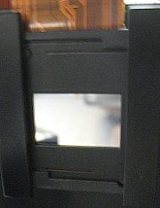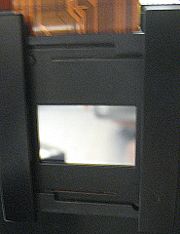
Spatial light modulator
Encyclopedia
A spatial light modulator (SLM) is an object that imposes some form of spatially-varying modulation
on a beam of light. A simple example is an overhead projector
transparency
. Usually when the phrase SLM is used, it means that the transparency can be controlled by a computer
. In the 1980s, large SLMs were placed on overhead projectors to project computer monitor contents to the screen. Since then more modern projectors
have been developed where the SLM is built inside the projector. These are commonly used in meetings of all kinds for presentations.
Usually, an SLM modulates the intensity
of the light beam. However, it is also possible to produce devices that modulate the phase
of the beam or both the intensity and the phase simultaneously.
SLMs are used extensively in holographic data storage
setups to encode information into a laser beam in exactly the same way as a transparency does for an overhead projector. They can also be used as part of a holographic display technology
.
SLMs have been used as a component in optical computing. They also often find application in holographic optical tweezers
.
 As its name implies, the image on an electrically addressed spatial light modulator is created and changed electronically, as in most electronic displays. EASLMs usually receive input via a conventional interface such as VGA or DVI input. They are commonly available at resolutions up to WUXGA (1920 × 1200). Unlike ordinary displays, they are usually much smaller (having an active area of about 2 cm²) as they are not normally meant to be viewed directly. An example of an EASLM is the Digital Micromirror Device
As its name implies, the image on an electrically addressed spatial light modulator is created and changed electronically, as in most electronic displays. EASLMs usually receive input via a conventional interface such as VGA or DVI input. They are commonly available at resolutions up to WUXGA (1920 × 1200). Unlike ordinary displays, they are usually much smaller (having an active area of about 2 cm²) as they are not normally meant to be viewed directly. An example of an EASLM is the Digital Micromirror Device
at the heart of DLP displays or Electrically controlled birefringent LCoS Displays.
, is created and changed by shining light encoded with an image on its front or back surface. A photosensor allows the OASLM to sense the brightness of each pixel and replicate the image using liquid crystal
s. As long as the OASLM is powered, the image is retained even after the light is extinguished. An electrical signal is used to clear the whole OASLM at once.
They are often used as the second stage of a very-high-resolution display, such as one for a computer-generated holographic display. In a process called active tiling, images displayed on an EASLM are sequentially transferred to different parts on an OASLM, before the whole image on the OASLM is presented to the viewer. As EASLMs can run as fast as 2500 frames per second, it is possible to tile around 100 copies of the image on the EASLM onto an OASLM while still displaying full-motion video on the OASLM. This potentially gives images with resolutions of above 100 megapixels.
for optimized peak power, and other specific pulse shapes). This technique features with full calibration and control of the ultrashort pulse, with no moving parts, and simple optical setup. Linear array SLMs that use nematic liquid crystal elements are available that can modulate amplitude, phase, or both simultaneously.
Modulation
In electronics and telecommunications, modulation is the process of varying one or more properties of a high-frequency periodic waveform, called the carrier signal, with a modulating signal which typically contains information to be transmitted...
on a beam of light. A simple example is an overhead projector
Overhead projector
An overhead projector is a variant of slide projector that is used to display images to an audience.-Mechanism:An overhead projector typically consists of a large box containing a very bright lamp and a fan to cool it. On top of the box is a large fresnel lens that collimates the light...
transparency
Transparency (projection)
A transparency, also known in industrial settings as a "viewfoil" or "foil", is a thin sheet of transparent flexible material, typically cellulose acetate, onto which figures can be drawn. These are then placed on an overhead projector for display to an audience...
. Usually when the phrase SLM is used, it means that the transparency can be controlled by a computer
Computer
A computer is a programmable machine designed to sequentially and automatically carry out a sequence of arithmetic or logical operations. The particular sequence of operations can be changed readily, allowing the computer to solve more than one kind of problem...
. In the 1980s, large SLMs were placed on overhead projectors to project computer monitor contents to the screen. Since then more modern projectors
Video projector
A video projector is an image projector that receives a video signal and projects the corresponding image on a projection screen using a lens system. All video projectors use a very bright light to project the image, and most modern ones can correct any curves, blurriness, and other...
have been developed where the SLM is built inside the projector. These are commonly used in meetings of all kinds for presentations.
Usually, an SLM modulates the intensity
Intensity (physics)
In physics, intensity is a measure of the energy flux, averaged over the period of the wave. The word "intensity" here is not synonymous with "strength", "amplitude", or "level", as it sometimes is in colloquial speech...
of the light beam. However, it is also possible to produce devices that modulate the phase
Phase (waves)
Phase in waves is the fraction of a wave cycle which has elapsed relative to an arbitrary point.-Formula:The phase of an oscillation or wave refers to a sinusoidal function such as the following:...
of the beam or both the intensity and the phase simultaneously.
SLMs are used extensively in holographic data storage
Holographic data storage
Holographic data storage is a potential technology in the area of high-capacity data storage currently dominated by magnetic and conventional optical data storage. Magnetic and optical data storage devices rely on individual bits being stored as distinct magnetic or optical changes on the surface...
setups to encode information into a laser beam in exactly the same way as a transparency does for an overhead projector. They can also be used as part of a holographic display technology
Phased array optics
Phased array optics is the technology of controlling the phase of light waves transmitting or reflecting from a two-dimensional surface by means of adjustable surface elements. It is the optical analog of phased array radar...
.
SLMs have been used as a component in optical computing. They also often find application in holographic optical tweezers
Optical tweezers
Optical tweezers are scientific instruments that use a highly focused laser beam to provide an attractive or repulsive force , depending on the refractive index mismatch to physically hold and move microscopic dielectric objects...
.
Electrically addressed spatial light modulator (EASLM)

Digital micromirror device
A digital micromirror device, or DMD, is an optical semiconductor that is the core of DLP projection technology, and was invented by Dr. Larry Hornbeck and Dr. William E. "Ed" Nelson of Texas Instruments in 1987....
at the heart of DLP displays or Electrically controlled birefringent LCoS Displays.
Optically addressed spatial light modulator (OASLM)
The image on an optically addressed spatial light modulator, also known as a light valveLight valve
A light valve is a device for varying the quantity of light, from a source, which reaches a target. Examples of targets are computer screen surfaces, or a wall screen in the case of a light projector....
, is created and changed by shining light encoded with an image on its front or back surface. A photosensor allows the OASLM to sense the brightness of each pixel and replicate the image using liquid crystal
Liquid crystal
Liquid crystals are a state of matter that have properties between those of a conventional liquid and those of a solid crystal. For instance, an LC may flow like a liquid, but its molecules may be oriented in a crystal-like way. There are many different types of LC phases, which can be...
s. As long as the OASLM is powered, the image is retained even after the light is extinguished. An electrical signal is used to clear the whole OASLM at once.
They are often used as the second stage of a very-high-resolution display, such as one for a computer-generated holographic display. In a process called active tiling, images displayed on an EASLM are sequentially transferred to different parts on an OASLM, before the whole image on the OASLM is presented to the viewer. As EASLMs can run as fast as 2500 frames per second, it is possible to tile around 100 copies of the image on the EASLM onto an OASLM while still displaying full-motion video on the OASLM. This potentially gives images with resolutions of above 100 megapixels.
Application in ultrafast pulse measuring and shaping
Multiphoton Intrapulse Interference Phase Scan (MIIPS) is a technique based on the computer-controlled phase scan of spatial light modulator. Through the phase scan to an ultrashort pulse, MIIPS can not only characterize but also manipulate the ultrashort pulse to get the needed pulse shape at target spot (such as Transform-Limited pulseBandwidth-limited pulse
A bandwidth-limited pulse is a pulse of a wave that has the minimum possible duration for a given spectral bandwidth. Optical pulses of this type can be generated by mode-locked lasers...
for optimized peak power, and other specific pulse shapes). This technique features with full calibration and control of the ultrashort pulse, with no moving parts, and simple optical setup. Linear array SLMs that use nematic liquid crystal elements are available that can modulate amplitude, phase, or both simultaneously.
See also
- Active filters in femtosecond pulse shapingFemtosecond pulse shapingIn optics, femtosecond pulse shaping is a technique that modifies the temporal profile of an ultrashort pulse from a laser. Pulse shaping can be used to shorten/elongate the duration of optical pulse, or to generate more complex pulses.-Introduction:...
.

